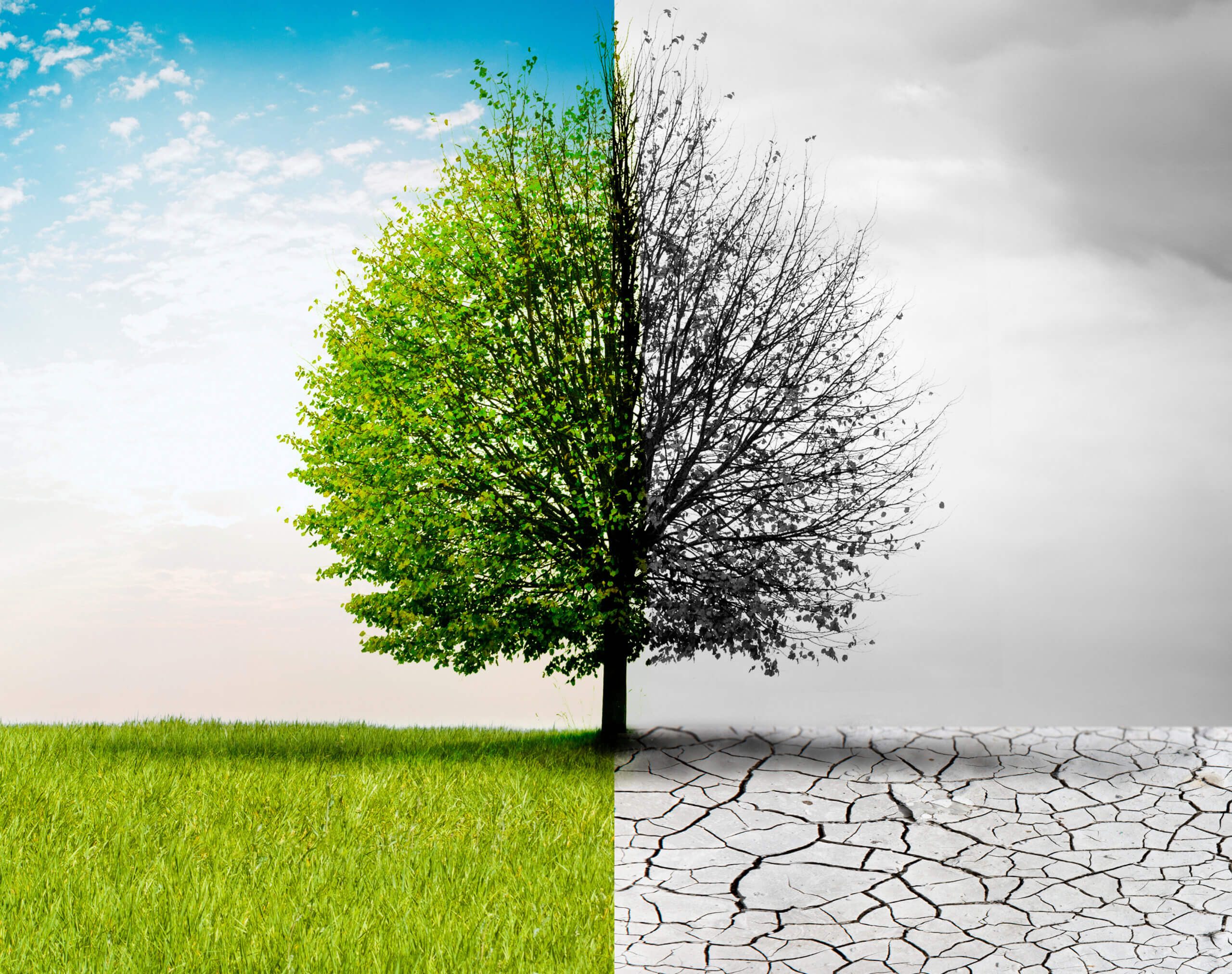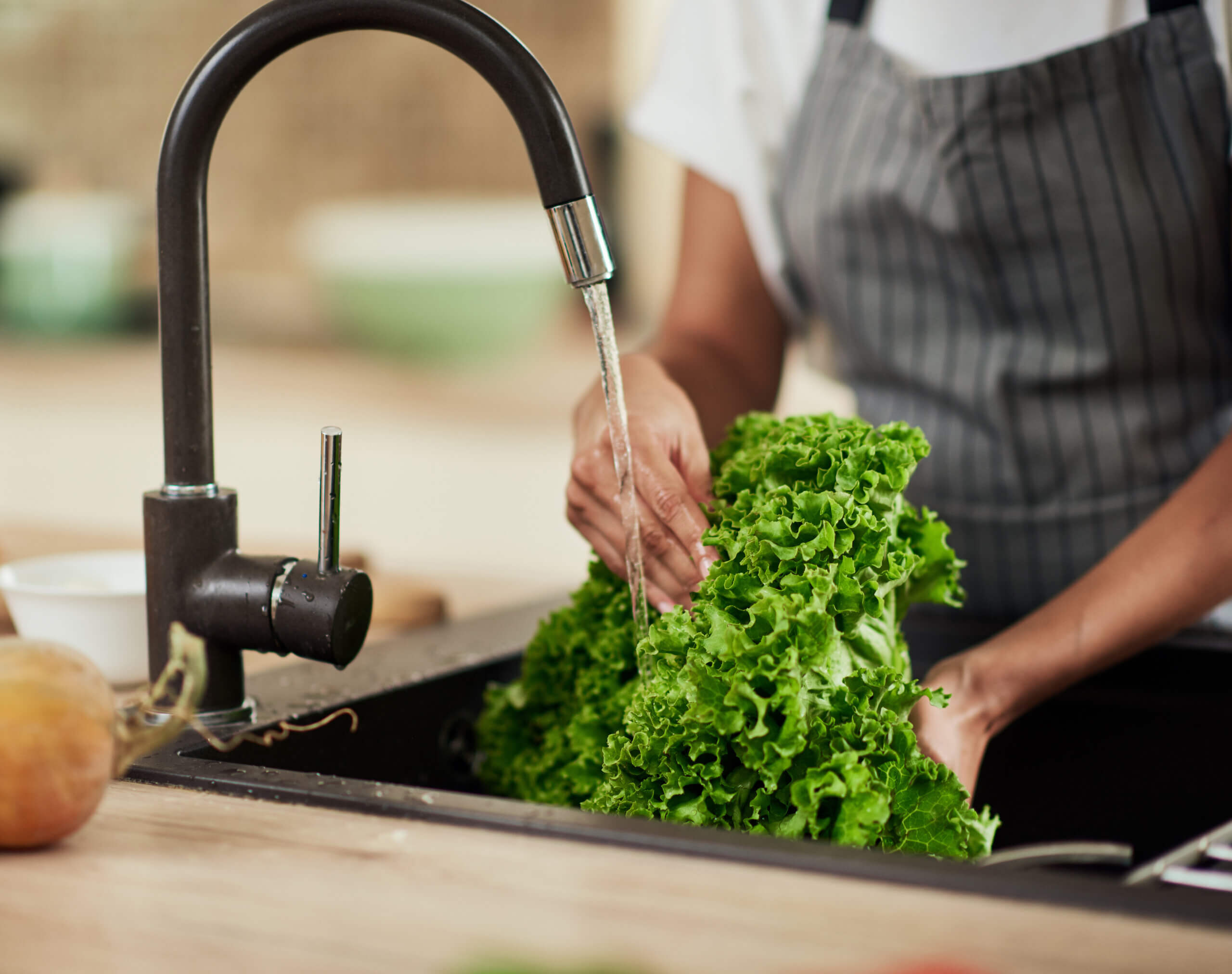Hey there, today we’re delving deeper into the world of vegan food and taking a closer look at its impact on the environment and climate change.
The environmentally friendly side of a vegan diet
A vegan diet has a significant positive impact on the environment and climate change. Avoiding animal products not only reduces the burden on natural resources, but also mitigates the negative consequences of livestock farming, which are often associated with deforestation, water wastage, biodiversity loss and high greenhouse gas emissions.
CO2 consumption in comparison: vegan vs. animal-based
Globally, food is responsible for 21-37% of all man-made greenhouse gases. [1] According to recent studies, meat consumption causes more greenhouse gas emissions worldwide (14.5 % to 18 %) than the entire global transport sector (13.5 %). High meat consumption in the countries of the global North, as in Austria, is the main driver of rainforest deforestation and biodiversity loss. A whopping 60.5 kg of meat is consumed on average per person per year in Austria. That is three times as much as recommended by the Austrian Society for Nutrition (ÖGE). [2] It is therefore not surprising that food accounts for 25-30% of all greenhouse gas emissions caused in Austria.
The current average omnivorous diet in Austria, which includes animal products, causes the most greenhouse gases at 1,467 kg CO₂-eq per person/year. By switching to a vegan, i.e. purely plant-based diet, consumption can be reduced to 439 kg CO₂-eq per person/year, which corresponds to a saving of 70 %. If we were to switch to a vegan diet and also mainly use organic products, consumption would be reduced again to 357 kg CO₂-eq per person/year, which corresponds to a saving of almost 76 %. [3]
The figures clearly show the enormous potential savings that can be made by switching to a plant-based diet.
CO2 equivalents(CO₂-eq) = is a unit of measurement for standardizing the climate impact of different greenhouse gases. In other words, theCO2 equivalent shows how strongly a gas such as methane (CH4) or nitrous oxide (N2O) affects our climate and the greenhouse effect. The effect of all greenhouse gases is compared with the effect of carbon dioxide (CO2). This is why these comparative values are called CO₂ equivalents. CO₂ equivalents are calculated for the various greenhouse gases. This figure is then usually given in grams ofCO2 equivalents(g CO₂-eq).



Meat consumption: a look at the consequences
Water consumption: Agriculture is responsible for 70% of water consumption worldwide. There are of course differences depending on the region, but on average the production of 1 kg of beef requires around 15,400 liters of water, 1 kg of pork requires 5,988 liters and 1 kg of poultry meat requires 4,325 liters of water. In contrast, 1 kg of wheat only requires around 1,800 liters and 1 kg of potatoes only 290 liters of water. [4, 5] A single dairy cow drinks an average of 150 liters of water per day, which corresponds to 54,700 liters of water per year. [6]
According to the Austrian food pyramid, adults should drink at least 1.5 liters of non-alcoholic, low-energy drinks such as water, mineral water, unsweetened fruit or herbal tea or highly diluted fruit and vegetable juices every day. If we stick with the 1.5 liters per person/day for our calculation example, then the annual consumption amounts to 547.50 liters of water. With the same amount of water that a cow needs per year, a person (1.5 liters per day) could be supplied with water for almost 100 years. You have to imagine that!
Land use: Livestock farming takes up around 77% of the world’s agricultural land, while the cultivation of cereals, fruit and vegetables only accounts for around 23%. [7] And this despite the fact that only 18% of the global calorie intake is covered by meat and milk and 82% by plant-based foods – crazy! [8] In Austria, around 60% of arable land is used to grow animal feed. If you include pastureland, around 80% of agricultural land in Austria is used to feed livestock. And yet Austria imports an additional 500,000 tons of soy feed from overseas every year, for which valuable forests are often destroyed. [9]
CO2 emissions: Every Austrian causes more than 2,500 kg of CO₂-eq per year through the consumption of animal products. This corresponds to the emissions that would be produced by a car journey from Vienna to Beijing and back. [10]
But that’s not all: in addition to carbon dioxide, livestock farming releases the greenhouse gas methane in particular. This is produced during the digestive process when plant-based food is processed. Cattle release methane into the atmosphere through belching and flatulence, where it causes much greater damage than carbon dioxide. Methane is also released into the atmosphere when manure is spread on fields, as it is found in the animals’ excrement. Methane has a 10 to 25 times greater impact on the greenhouse effect than carbon dioxide, making it up to 25 times more harmful to the climate thanCO2. It also remains in the atmosphere for up to 15 years and contributes a good 16% to the greenhouse effect.
One cow produces an annual average of over 100 kg of methane through digestion and fermentation processes. In terms of climate-damaging effects, this corresponds to theCO2 emissions of 18,000 kilometers driven by car. On top of this, however, there are the actual excretions of a cow: 90 additional kilograms of methane per year are produced through its excrement.
If you think it can’t get any worse, then I’m sorry to disappoint you. May I introduce: Nitrous oxide. Nitrous oxide (N2O), also known as dinitrogen monoxide, is mainly released during fertilization. Both manure and slurry as well as industrially produced fertilizers contain nitrogen. When nitrogen-containing compounds are broken down, nitrous oxide is produced. It remains in the atmosphere for around 114 years and is 300 times more harmful to the climate thanCO2.
A small comparison: a 1 ha fertilized field has about the same impact on the climate in one year as 10,000 km driven by car.
Organic farms do not use mineral fertilizers and chemical pesticides. This at least improves their carbon footprint. [11]
Destruction of nature: Most of the world’s soy is grown in the USA, Brazil, Paraguay and Argentina. An incredible 77% of the global soy harvest is used as animal feed in the livestock industry – mainly in the form of meal – while just 19% is used to produce soy products consumed by vegans. The remaining 4% or so is used in the biodiesel and lubricants industry. [12] Due to the increasing global demand for soy, huge areas of valuable rainforests and wooded savannahs are being lost forever every year in the countries of origin due to the reckless expansion of agricultural land. [10] The destruction of these extremely species-rich ecosystems is associated with high greenhouse gas emissions, negative socio-economic consequences such as child labor and, in particular, a great loss of biodiversity. And as an importing country, Austria and we consumers are contributing to this.

The insatiable hunger for soy
With over 230,000 tons per year, Austria is the fourth largest soya producer in Europe, after Italy, France and Romania. The total area under soy cultivation in Austria in 2023 amounted to around 93,000 hectares – that is more than twice the area of Vienna and almost five times as much as was cultivated in 2008 (19,000 hectares). Burgenland, Lower Austria and Upper Austria produce the most soy. Our small country therefore makes a significant contribution to Europe’s self-sufficiency in vegetable protein sources, but this amount is still nowhere near enough to cover the quantities required by the livestock industry. Austria therefore imports most of its soya from Brazil (185,800 tons or 25 %), followed by Argentina (144,500 tons or 20 %) and the USA (101,700 tons or 14 %). [13, 14]
A study by the University of Natural Resources and Life Sciences, Vienna and the Research Institute of Organic Agriculture shows that even more soy is imported into Austria as animal feed than previously assumed. According to the study, over 740,000 tons of soya, the majority of which is genetically modified, is imported into Austria as animal feed every year. [15] This produces around 3 million tons of CO₂-eq per year. However, these GHG emissions are not attributed to Austria, but to the countries of origin, even though Austria causes them through its demand – absurd! [16]
“
Plans to protect the air and water, the wilderness and nature, are also plans to protect people.
Stewart Udall
Why does soy play such an important role in factory farming?
Soybeans are rich in vegetable protein, iron, magnesium and other minerals that significantly promote animal growth. In addition, soy is available on the world market in large quantities and at low prices. Animal factories feed soy combined with added hormones and antibiotics in order to produce large quantities of meat, eggs or milk quickly and cheaply and thus increase their profits. [17]
Is it okay if I eat products made from soy?
As already mentioned, tofu and soy products for direct human consumption account for only a small proportion of soy production. It should also be noted that soy is not problematic per se, but that its use as animal feed is very inefficient. Up to 16 kg of animal feed is needed to produce one kilogram of meat, depending on the type of animal and how it is reared. In contrast, around 2 kg of tofu can be produced from one kilogram of soy. Most of the soy used in Austrian products (such as tofu) is also grown in Austria. [10, 18]
If everyone met their protein requirements with soy instead of meat and milk, the environmental impact could be reduced by around five times. Soybeans contain all nine essential amino acids (i.e. all those that the human body cannot produce itself). This is why it is also known in China as the “meat of the earth”. From a nutritional point of view, people who eat soy products do not need animal proteins. It is ideal to buy organically produced soy products from Austria and alternate them with other pulses such as beans, peas, lupins and lentils. Side recommendation: Seitan is a delicious meat alternative. [17]
Sustainability seems to be an omnipresent topic in the public eye, numerous NGOs have dedicated themselves to protecting our planet and many parties and politicians boast of their commitment to environmental protection. Nevertheless, almost everyone ignores the fact that no other economic sector causes as much ecological damage as the animal industry. It is responsible for around 14.5% to 18% of global greenhouse gases and therefore has a greater impact on climate change than the transportation sector. Furthermore, the production of animal-based food is the driving factor behind water pollution, deforestation and species extinction worldwide.
The Netflix documentary “Cowspiracy” presents extensive and astonishing facts and figures on the ecological impact of the animal industry. Click here for the trailer.
Eating Our Way to Extinction is a documentary starring Kate Winslet that takes viewers on a journey around the world and shows the things no one wants to talk about.
This hard-hitting vegan documentary sends a simple but powerful message by exposing hard truths and addressing the most pressing issue of our generation – ecological collapse.
Impressive pictures and a message that urgently needs to be shared! Click here for the German version.
A comparison of CO2 footprints: Animal vs. vegan foods
But now we want to know more precisely and are therefore looking at individual products. The figures are greenhouse gas emissions in kilograms of carbon dioxide equivalents (CO₂-eq) per kilogram of food – taking into account Soil change, farming & cultivation, animal feed, processing, transportation, trade, packaging, losses. [19, 20]
Animal foods:
- Beef: 99 kg CO₂-eq /kg
- Lamb meat: 40 kg CO₂-eq /kg
- Shrimps (farmed): 27 kg CO₂-eq /kg
- Cheese: 24 kg CO₂-eq /kg
- Fish (farmed): 14 kg CO₂-eq /kg
- Pork: 12 kg CO₂-eq /kg
- Butter: 12 kg CO₂-eq /kg
- Chicken meat: 9.9 kg CO₂-eq /kg
- Eggs: 4.7 kg CO₂-eq /kg
- Milk: 3.2 kg CO₂-eq /kg
Vegan food:
- Maize: 1.7 kg CO₂-eq /kg
- Tofu: 3.2 kg CO₂-eq /kg
- Broccoli: 0.7 kg CO₂-eq /kg
- Tomatoes: 2.1 kg CO₂-eq /kg
- Rice: 4.5 kg CO₂-eq /kg
- Wheat & roe: 1.6 kg CO₂-eq /kg
- Beans: 0.98 CO₂-eq /kg
- Bananas: 0.86 CO₂-eq /kg
- Potatoes: 0.46 CO₂-eq /kg
- Apples: 0.43 CO₂-eq /kg
As you can see, plant-based products clearly have the edge here.
Psychological hurdles when switching to a vegan diet
Why do many people find it difficult to switch to a vegan diet? From a psychological point of view, habits, social norms and emotional attachment to certain foods play a role. But you can change – where there’s a will, there’s a way!
A vegan diet is not only good for our health, but also for our planet. A general reduction in meat consumption would already lead to lower greenhouse gas emissions, lower water consumption and reduced use of natural resources. In addition, less animal transportation would be necessary. Each and every one of us has the opportunity to reduce our ecological footprint by opting for plant-based products without sacrificing our quality of life. Such a step would have a positive impact on the climate and therefore on us all.
Read more here about the impressive health benefits of a vegan diet.
Disclaimer: This text is in no way a substitute for professional advice from a doctor or pharmacist and must not be used as a basis for independent diagnosis or for starting, changing or stopping treatment of illnesses. Always consult a doctor you trust if you have any health questions or complaints! Greentrinsic accepts no liability for any inconvenience or damage resulting from the use of the information presented here.
Sources:
1. IPCC (2019): Climate Change and Land. An IPCC Special Report on climate change, desertification, land degradation, sustainable land management, food security, and greenhouse gas fluxes in terrestrial ecosystems, Summary for Policymakers,(https://www.ipcc.ch/site/assets/uploads/sites/4/2020/02/SPM_Updated-Jan20.pdf)
2 Schlatzer, M.; Lindenthal, T. (2022): The effects of a reduction in meat consumption on animal husbandry, animal welfare and climate in Austria – taking into account a 100% organic scenario,(https://media.4-paws.org/0/0/8/a/008a54b141a2301fb5713f8ebde0a22b8e2aa1fa/Schlatzer%20u%20Lindenthal_2022_Tierhaltung%20Tierwohl%20and%20Klima%20in%20AUT_Endber….pdf)
3 Schlatzer, M.; Lindenthal, T. (2022): Influence of different diets on the climate. Climate Change Center Austria,(https://ccca.ac.at/fileadmin/00_DokumenteHauptmenue/02_Klimawissen/FactSheets/37_ernaehrung_202204.pdf)
4 Albert Swiss Institute for our environment (2016): What’s behind a kilogram of beef,(https://albert-schweitzer-stiftung.de/aktuell/1-kg-rindfleisch)
5 Weltfriedensdienst e.V. (2024): The farm animal – a water eater,(https://wfd.de/thema/fleisch-milch)
6th Association against Animal Factories (2020): Climate killer cow,(https://vgt.at/presse/news/2020/news20200327ih.php#4)
7 Our World in Data (2019): Land Use. OurWorldInData.org,(https://ourworldindata.org/land-use)
8 Proveg International (2023): Inefficient land use: enormous land consumption by animal agriculture,(https://proveg.com/de/5-pros/pro-umwelt/landnutzung/)
9th Greenpeace Report (2020): The myth of self-sufficiency – Why Austria imports so much fruit and vegetables.(https://greenpeace.at/news/blog-mythos-eigenversorgung/)
10. WWF (2024): Meat consumption: Our great hunger,(https://www.wwf.at/nachhaltig-leben/fleisch/)
11 ARD alpha (2022): Climate killer cow: belches and farts release methane,(https://www.ardalpha.de/wissen/umwelt/klima/klimawandel/kuh-kuehe-rind-rinder-methan-klima-landwirtschaft-treibhausgase-100.html)
12 Albert Schweizer Stiftung für unsere Mitwelt (2018): Why soy sausage does not harm the rainforest,(https://albert-schweitzer-stiftung.de/aktuell/warum-sojawurst-nicht-dem-regenwald-schadet)
13. soy from Austria (2024): Figures & Data,(https://soja-aus-oesterreich.at/zahlen-daten/)
14 Austria eats informed (2023): Soy in the fact check,(https://www.oesterreich-isst-informiert.at/tipps-service/soja-im-faktencheck/)
15 Oekoreich (2021): New study: Austria imports 740 million kilos of soy annually as animal feed,(https://www.oekoreich.com/medium/neue-studie-oesterreich-importiert-jaehrlich-740-millionen-kilo-soja-als-tierfutter)
16 Schlatzer, M.; Drapela T.; Lindenthal, T. (2021): The impact of Austrian imports of selected foods on land use, biodiversity and greenhouse gas emissions in the growing regions of the global South. University of Natural Resources and Life Sciences, Vienna in cooperation with the Center for Global Change and Sustainability,(https://orgprints.org/id/eprint/40035/1/schlatzer-etal-2021-FiBL_at_Studie_import_auswirkungen_2105.pdf)
17 Save the rainforest (2024): Questions and answers on soy,(https://www.regenwald.org/themen/fleisch-soja/fragen-und-antworten-zu-soja)
18. nahgenuss (2017): How the use of soy animal feed is destroying the rainforest,(https://www.nahgenuss.at/blog/soja-tierfutter/)
19 Poore, J.; Nemecek, T. (2018): Food: greenhous gas emissions across the supply chain. Our World in Data;(https://ourworldindata.org/grapher/food-emissions-supply-chain?country=Beef+%28beef+herd%29~Cheese~Poultry+Meat~Milk~Eggs~Rice~Pig+Meat~Peas~Bananas~Wheat+%26+Rye~Fish+%28farmed%29~Lamb+%26+Mutton~Beef+%28dairy+herd%29~Shrimps+%28farmed%29~Tofu~Maize~Coffee~Other+Pulses~Citrus+Fruit~Other+Fruit~Sunflower+Oil~Apples~Brassicas~Olive+Oil~Potatoes~Palm+Oil~Barley~Soybean+Oil~Wine~Root+Vegetables~Dark+Chocolate~Cane+Sugar~Nuts~Tomatoes~Rapeseed+Oil~Groundnuts)
20 Panny, S. (2020): How much greenhouse gas does your food actually produce? Moment.at Magazine,(https://www.moment.at/story/wie-viel-treibhausgas-produziert-dein-essen-eigentlich)




